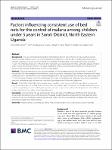| dc.contributor.author | Akello, Anne Ruth | |
| dc.contributor.author | Byagamy, John Paul | |
| dc.contributor.author | Etajak, Samuel | |
| dc.contributor.author | Okadhi, Charles Stephen | |
| dc.contributor.author | Yeka, Adoke | |
| dc.date.accessioned | 2022-12-05T14:00:04Z | |
| dc.date.available | 2022-12-05T14:00:04Z | |
| dc.date.issued | 2022 | |
| dc.identifier.citation | Akello, A. R., Byagamy, J. P., Etajak, S., Okadhi, C. S., & Yeka, A. (2022). Factors influencing consistent use of bed nets for the control of malaria among children under five years in Soroti District, North Eastern Uganda. | en_US |
| dc.identifier.uri | https://doi.org/10.1186/s12936-022-04396-z | |
| dc.identifier.uri | http://ir.lirauni.ac.ug/xmlui/handle/123456789/453 | |
| dc.description.abstract | Background: The use of insecticide-treated bed nets has been proven to be effective in reducing malaria transmission
in highly endemic areas. Use of long-lasting insecticidal nets (LLINs) has been embraced by many malaria
endemic countries. LLINs are up to 95% effective in inhibiting blood feeding, when used consistently even after
7 years. The challenge, however, is enhancing their consistent use, especially by the most vulnerable groups (children
under 5 years and pregnant women). The study established factors associated with consistent use of bed nets for
malaria control among children under 5 years in Soroti district.
Methods: The study employed a cross-sectional design, with multi-stage sampling of households. A total of 400
households (HH) were sampled and the HH head in each household interviewed. Key informant interviews (KIIs) were
conducted with 7 key informants who were knowledgeable on the subject matter. Data analysis was done using SPSS
17.0 at Univariate, Bivariate and Multivariable levels; after entry and cleaning. Key informants’ data were summarized
manually; verbatim quotes and text used to reinforce quantitative data in line with objectives.
Results: Only 56.8% of the 690 children under 5 years used bed nets consistently. The factors affecting consistent
bed net use were age of the child, their use of bed nets the previous night, occupation of caretaker, respondents’ perceived
susceptibility, perceived risk of getting malaria, size and shape of the bed nets. Rectangular nets were difficult
to hang daily in huts according to most key informants.
Conclusion: Consistent bed net use among under fives is still below the RBM target of 85% by 2015 and can be
enhanced by providing conical bed nets and setting aside a health education programme to emphasize the effectiveness
of even one mosquito in spreading malaria at night to the entire household and ability of bed nets to stop
transmission better than other methods. | en_US |
| dc.language.iso | en | en_US |
| dc.publisher | Malaria Journal | en_US |
| dc.subject | Malaria control | en_US |
| dc.subject | Consistent use of bed nets | en_US |
| dc.subject | Children under 5 years | en_US |
| dc.subject | Soroti district | en_US |
| dc.subject | Eastern Uganda | en_US |
| dc.title | Factors influencing consistent use of bed nets for the control of malaria among children under 5 years in Soroti District, North Eastern Uganda | en_US |
| dc.type | Article | en_US |

